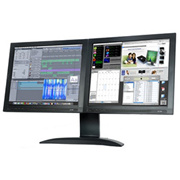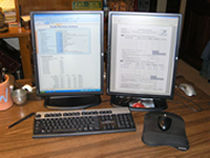
The problem arises in situations where you want to look at two documents at the same time, typically to compare the information from one document against the other. An example might be checking a list of open invoices against a summary of payments received. Another would be verifying a printout of back ordered items against a shipping receipt.
In these situations, paper documents (for all their disadvantages) work well. We go the filing cabinet, retrieve the two documents and place them next to each other on the desktop – just as we have always done.
But…when the two documents we want to compare are stored in electronic format, we run into a”real estate” problem. With just a single screen to work with, we are forced to flip back and forth between the two documents, maximizing first one document, then the other. This is cumbersome and irritating at best and will generate a lot of negative feedback from those users that need to do this on a regular basis.

A major step that you can take to insure that your staff enjoys working with electronic documents is to add a second monitor to their computer workstations.
There are several big benefits that you will gain by doing this; but to appreciate them we need to first take a minute to talk about the one potential drawback you are likely to encounter when you and your staff begin working in an electronic document environment.
Fortunately, having a dual monitor setup solves this problem quickly and easily. Now we can simultaneously display the first document on monitor 1 and the second document on monitor 2, eliminating the problem completely.
Plus, when we are finished, we do not have to take the time to re-file the documents in a cabinet, when we close the documents they will be automatically returned to their proper location in the electronic filing system.

The benefits don’t stop there however. With two monitors, you can keep any two programs that you are working with open and maximized at the same time.
For example, let’s suppose you are writing a technical paper or a financial report (using Word perhaps) and you are referencing source documents that you have stored on the computer as you go along. With a second monitor you can keep them open for easy viewing on one screen while you compose your document on the other.
Or again, if you are doing research on the web, you will find it so easy to drag pertinent information from a website directly into a word doc (dragging across from one screen to the other).
Think about all of the times you have more than one program open at the same time and you will start to get a feel for how useful this can be. As a matter of fact, Microsoft has conducted studies that show that a dual monitor setup will increase productivity by anywhere from 20 to 35%!
Easy and Inexpensive
The best thing is that this is a very low cost innovation to put in place. Essentially, all you need is a video card that will support two monitors (these sell for about $60) and, of course, a second monitor. (Note - although the picture above shows two monitors mounted on one stand, a more common setup is to have each monitor mounted on its own stand).
If you are running Windows XP there is no additional software to install - it will support dual monitors automatically. In most cases, you merely install the video card and plug the two monitors into it. Then you turn on your machine and Windows XP will open them both automatically.
Finally, the learning curve is almost non-existent. You start with your cursor on the left hand screen and drag it to the right. When the cursor hits the right hand edge of monitor one you keep dragging and it pops up on the left hand edge of monitor two. It is really that simple.
Our suggestion is that you try it out with one workstation and see if it makes sense. Then roll it out to the other workstations – your staff will be thrilled.